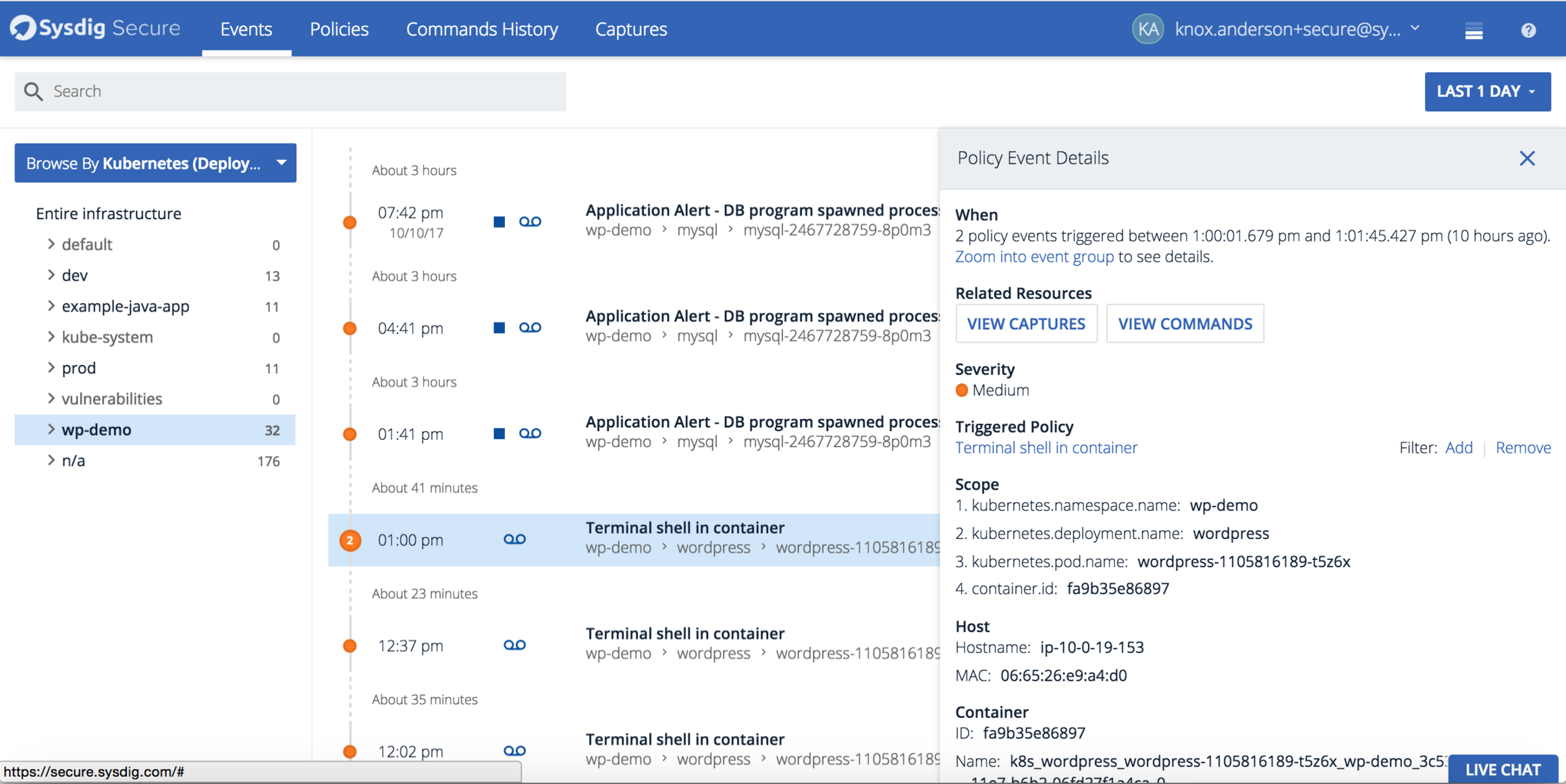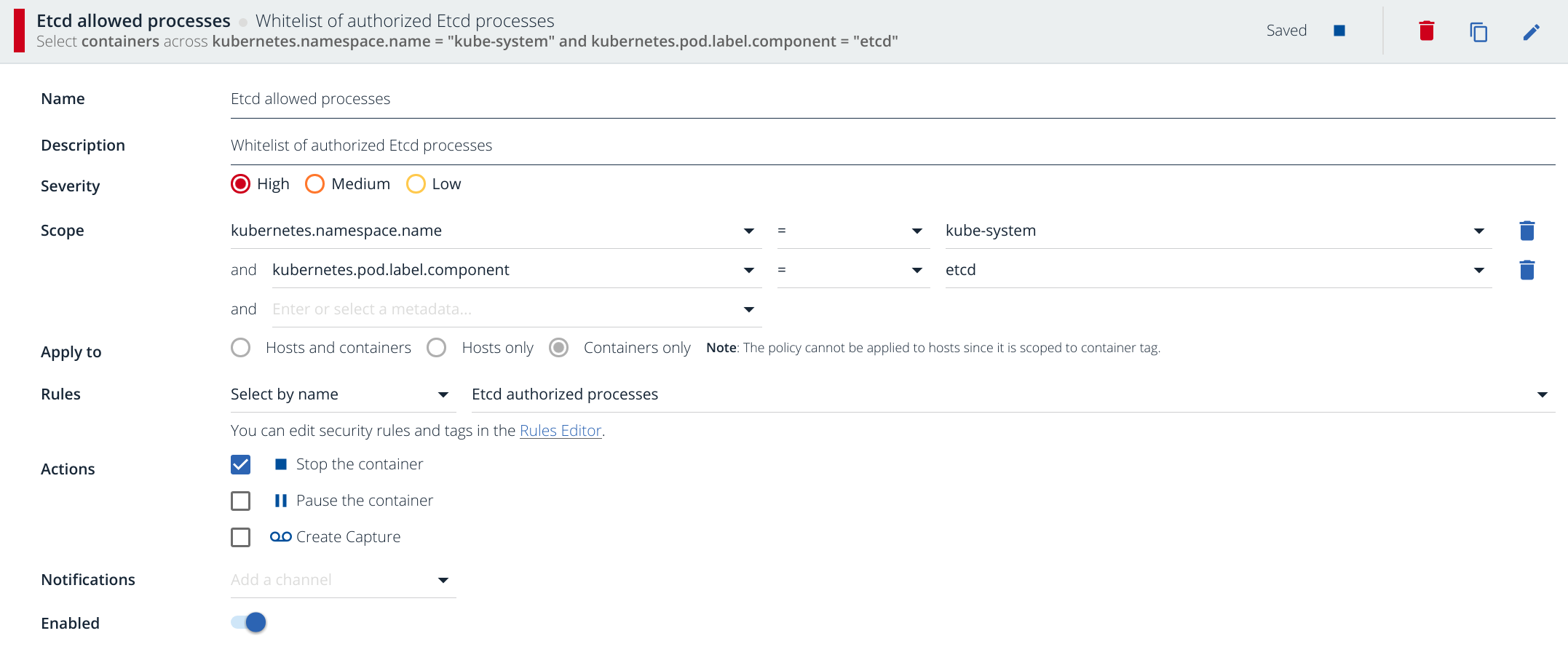
Falco Feeds extends the power of Falco by giving open source-focused companies access to expert-written rules that are continuously updated as new threats are discovered.

Are you looking at how to improve your Kubernetes security? We have put together here the best practices for implementing run-time security on the kube-system components (kubelet, apiserver, scheduler, kubedns, etc) deployed in Docker containers.
One of the main sources of concern for companies approaching the container paradigm has traditionally been security. It's a radical infrastructure switch after all, and certain level of caution is perfectly healthy.
Kubernetes devs are aware of this and the platform has improved leaps and bounds in this respect. Work on the RBAC API, integrated secrets vault or certificate rotation mechanisms are the latest examples of this effort.
Kubernetes security is a vast topic already, with several guidelines written by the project itself and many third parties. These guides focus on tuning cluster configuration parameters, restricting user privileges or secret management. But what if somebody finds a way to bypass those? Or a software component does something unexpected because it suffers from a bug or security vulnerability that your static scanning will never catch?
Run-time security provides an extra layer of protection for those times malicious users or software behave in a way you didn't prepare for.
In this article we are going to create and test Kubernetes run-time security policies using Sysdig Secure, our container native security and forensics product.
Let's describe the kube-system components that we are going to consider for this article.
kube-system security: Core components
Kubernetes clusters can have different building blocks, some of them are optional like the dashboard, your preferred service mesh broker, or a SDN implementation but these are the core components that you will find everywhere and we are going to cover here:
kube-apiserver: The central communications hub of the cluster. Provides REST endpoints to interact with the other cluster entities and stores the distributed state in the etcd backend.
etcd: The database backend where the cluster configuration, state and related information persists.
kube-controller-manager: This component implements the main control loop, in other words, it observes the differences between the current and desired cluster states and performs the changes needed to move towards desired state. When you launch a ReplicationController, it gets included in this component.
kube-scheduler: Watches newly created pods that have no node assigned, and selects a node for them to run on. From version 1.6 onwards, you can plug in your own custom Kubernetes scheduler.
kube-dns: Unsurprisingly, an internal cluster DNS server. Kube DNS will automatically configure registers for Kubernetes namespaces, services and pods. This way the pods can easily locate other services in the cluster.
kubelet: The cluster agent that runs on every Kubernetes node. The kubelet launches the pods using the available container engine (Docker, rkt, etc) and periodically checks and reports pod status.
kube-proxy: Another service that runs on every node, providing the necessary network translation between service endpoints and pods.
The kubelet and kube-proxy run as processes directly in the Kubernetes nodes, the other components are typically run as cluster Docker containers inside the kube-system namespace.
Kubernetes security by default with Sysdig Secure
We are going to produce a security ruleset for these components using a whitelisting approach (explicitly declaring valid entities, banning everything else). The container/microservice paradigm goes very well with this approach because containers are already minimal and predictable by design.
Sysdig Secure
Sysdig Secure, part of the Sysdig Container Intelligence Platform, is designed to provide container run-time security & forensics for enterprises. Sysdig Secure's deep container visibility provides insight into what's happening inside the containers and leverages key orchestration technologies like Kubernetes, Docker, OpenShift, Amazon ECS to bring in metadata and apply rules from a service and application perspective.

The Sysdig Secure rule syntax is the same used in Sysdig Falco, and is documented here. Anyways, most of the rules that we are going to use are quite self-explanatory.
kube-system process security
One of the easiest and most effective whitelist that you can configure is the list of allowed processes. This task that would be somewhat tedious and error prone in a classical all-purpose server, but it's quite straightforward for microservices.
For example, let's see the processes on our etcd service container:
So, basically just the etcd process, anything else would be extremely suspicious.
Let's take a look to the API server:
Similarly, a single process running here.
So, you can write a Sysdig Secure list and rule similar to this one:
And the following Kubernetes security policy:

We wrote already on Sysdig Secure: Docker run-time security about the policy creation process more in detail. In a nutshell: you are restricting the scope of this rule to kubernetes.namespace.name=kube-system and Docker containers with the label component=etcd. This security violation is critical enough to stop the container immediately (see Actions) and of course, on a real scenario you will configure several notification channels, typically email or Slack but you can also go for webhooks, VictorOps, PagerDuty, etc.
Let's trigger it the policy we just created, opening a shell ino the etcd container and running any process, for example:
Notice that I have been automatically expelled from the container. The container where I was running that command has been inmediately killed by Sysdig.
You will get the event in your Sysdig Secure stream and clicking on it you will be able to see the detail (just including the sections relevant for this example below):

For the sake of brevity, we are only going to include the YAML rules for the next sections, as you have seen, creating and testing the corresponding Sysdig Secure policies is a straightforward process.
Trusted containers in Kubernetes kube-system
In conjunction with other tools to run your own images registry, Sysdig Secure offers an additional layer of run-time security against the use of untrusted containers. This is especially important for the kube-system namespace where the allowed list of pods is pretty small and immutable. The following rule will automatically detect (and kill) any container that doesn't come from any of the allowed images:
Kubernetes secrets security: process tries to read a secret after boot
Kubernetes has a secrets mechanism to securely initialize pods with artifacts like private keys, passwords, tokens, etc. Generally, a pod will need to access its secrets during start up. You can detected if a long running process tries to access a secret file.
Assuming you mount your secrets under /etc/secrets (replace with your configured path) this rule will detect and react when a process in a container reads those sensible files:
Pods trying to connect to their local kubelet
In a Kubernetes cluster, the API server talks to the kubelets and these set up the pods in each node. Usually, the pods shouldn't connect to the kubelet or try to scrape its metrics unless you have a service that explicitly needs that. Let's fire an alarm if we detect this behavior.
The API server connects to the kubelet service using port 10250. 10255 and 10248 (now deprecated) are read-only health check and stats ports. To detect any pod connecting to the local kubelet, we will use a rule like this:
kube-system user security policies
Another common attack symptom could be the modification of attributes and permissions of the default users to gain access to privileged information (forging an URL for example).
These kube-system components do not need to modify or create any new user, you can detect and alert if any container tries to perform these actions.
Conveniently enough, there are already lists and macros for the user management tools. The following rule makes it super easy:
Let's test this policy:

In this case we have been looking for user related changes but the default ruleset of Sysdig Secure already detects any write below /etc, this offers you extra protection in case the attacker tries to change the valid sources of users, for example modifying /etc/nsswitch.conf ;-).
Kubernetes file system security: write-allowed directories
Most container directories are generally static and read-only. The list of write-allowed directories should be easy to define and any violation immediately detected. This is an example to detect writes outside the allowed path:
Kubernetes network security: processes opening a listening port
Other interesting whitelist is the list of processes allowed to open a listening connection. For example, in this rule we only let kube-proxy to open listening ports:
Kubernetes network security: Processes opening an outbound connection
The list of processes that can initiate a connection from your kube-system pods should be fairly limited as well, let's take advantage of that. For example here, only kube-apiserver can initate an outbound connection:
Let's try it:
Alert description text:
Kubernetes network security: Detecting NodePort endpoints
A human error or maybe a malicious user can configure a service as type Nodeport, thus bypassing the firewalls and other security measures that you have configured for your load balancers:
30000 to 32767 is the default port range in Kubernetes for NodePort services. This is a rule to detect that:
Default Sysdig Secure rules and policies
In addition to all the security rules and policies that we just listed, the default Sysdig Secure policies had been designed to protect containers from several common threats and attacks. Most of them will be useful to protect your kube-system out of the box, or with some minor customizations.
You will find policies like:
- Modify binary dirs: an attempt to modify any file below a set of binary directories.
- Change thread namespace: an attempt to change a program/thread namespace (commonly done as a part of creating a container) by calling setns.
- Launch Sensitive Mount Container: detect the initial process started by a container that has a mount from a sensitive host directory (i.e. /proc). Exceptions are made for known trusted images.
- Launch Privileged Container: detect the initial process started in a privileged container. Exceptions are made for known trusted images.
- System procs network activity: any network activity performed by system binaries that are not expected to send or receive any network traffic.
Auto generate Kubernetes security rules and policies
Creating all these whitelisting rules by hand can be laborious, you can auto generate the rules that will be used as base for your policies using the following YAML format:
This input file will auto generate the mentioned whitelisting rules for processes, write-allowed directories, process allowed to start outbound connections and process allowed to open listening ports.
And this simple python script.
This will automatically generate a ruleset that you can directly copy and paste as custom rules for Sysdig Secure.
Conclusions
Strict run-time security for your kube-system pods is an effective mechanism against any attack that has already bypassed your existing security measures or that managed to exploit a new vulnerability.
Get a free Sysdig Secure trial and protect your containers and microservices with run-time security or learn more about Sysdig Falco (single host, command line only), the open source relative of Sysdig Secure.


